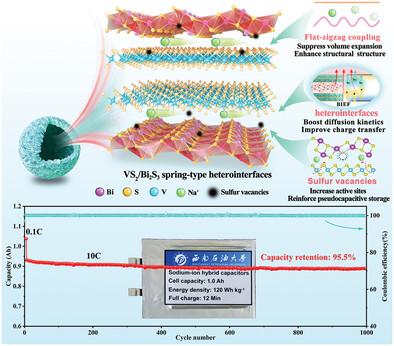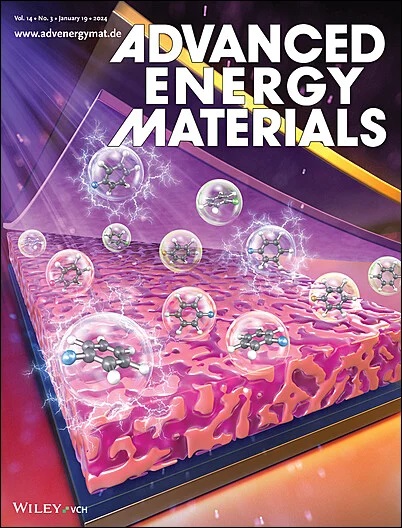VS2/Bi2S3 Spring‐Type Heterointerfaces Hollow Microspheres with Spatial Confinement and Vacancy Defects for Fast‐Charging and Ampere‐Hour Scale Pouch Sodium‐Ion Hybrid Capacitors
IF 24.4
1区 材料科学
Q1 CHEMISTRY, PHYSICAL
引用次数: 0
Abstract
Optimizing electrochemical kinetics by regulation ion/charge transfer efficiency and stabilizing the electrode structure of electrode materials is crucial to maximize the rapid charging and long cycling sodium‐ion storage. Herein, VS

具有空间约束和空位缺陷的VS2/Bi2S3弹簧型异质界面空心微球用于快速充电和安培小时尺度袋状钠离子混合电容器
通过调节离子/电荷转移效率来优化电化学动力学和稳定电极材料的电极结构是实现钠离子快速充电和长循环储存的关键。本文合成了具有空间约束和硫空位缺陷的VS2/Bi2S3弹簧型异质界面空心微球,作为钠离子混合电容器(sihc)的快速充电阳极。实验研究和密度泛函理论计算验证了VS2和Bi2S3之间的强耦合诱导了一个稳定的内建电场,极大地提高了电荷和钠离子的转移效率。异质界面处的硫空位缺陷产生了额外的钠离子赝电容存储,提高了VS2/Bi2S3电极的可逆容量和大速率快充性能。有限元分析和原位膨胀试验证实,由平面形态VS2和之形形态Bi2S3叠层形成的弹簧型异质结构空心微球可以减轻钠离子插入/提取过程中晶格的膨胀和收缩,调节机械应力,保持异质结界面的完整性。当用于硬币SIHC时,它实现了135 Wh kg - 1/22 kW kg - 1的高能量/功率密度,以及5万次循环的超长寿命;组装的小袋SIHC (1 Ah)在10℃下快速充电时显示出120 Wh kg−1的高比能,1000次循环后容量保持率为95.5%。
本文章由计算机程序翻译,如有差异,请以英文原文为准。
求助全文
约1分钟内获得全文
求助全文
来源期刊

Advanced Energy Materials
CHEMISTRY, PHYSICAL-ENERGY & FUELS
CiteScore
41.90
自引率
4.00%
发文量
889
审稿时长
1.4 months
期刊介绍:
Established in 2011, Advanced Energy Materials is an international, interdisciplinary, English-language journal that focuses on materials used in energy harvesting, conversion, and storage. It is regarded as a top-quality journal alongside Advanced Materials, Advanced Functional Materials, and Small.
With a 2022 Impact Factor of 27.8, Advanced Energy Materials is considered a prime source for the best energy-related research. The journal covers a wide range of topics in energy-related research, including organic and inorganic photovoltaics, batteries and supercapacitors, fuel cells, hydrogen generation and storage, thermoelectrics, water splitting and photocatalysis, solar fuels and thermosolar power, magnetocalorics, and piezoelectronics.
The readership of Advanced Energy Materials includes materials scientists, chemists, physicists, and engineers in both academia and industry. The journal is indexed in various databases and collections, such as Advanced Technologies & Aerospace Database, FIZ Karlsruhe, INSPEC (IET), Science Citation Index Expanded, Technology Collection, and Web of Science, among others.
 求助内容:
求助内容: 应助结果提醒方式:
应助结果提醒方式:


